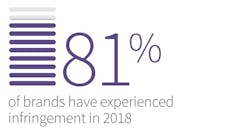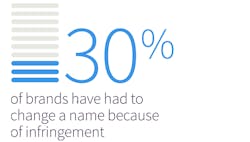Over the last few decades, the growing global economy, emerging markets with valuable intellectual property (IP) , and business opportunities based on online commerce have led to more trademarks being filed to take advantage of commercial opportunities. Today, there are more trademarks than ever before and, according to the World Intellectual Property Organization (WIPO), the number of trademark application filings is rising exponentially, with a 30% spike in 2017 compared to the year before. This rise equates to roughly 9.11 million applications filed. What this means for marketers, creative agencies, and trademark attorneys is that creating and filing a unique trademark across several jurisdictions is now a major challenge.
This increase can be attributed to a number of factors, including an expansion of China trademarks. That country was behind the 30% increase in the number of trademark filings in 2017, with 5.75 million marks filed there that year. Other factors include the proliferation of commercial activity on the internet and social media, and brands filing marks across global markets.
With the increase of trademark registrations, brand owners are finding it increasingly difficult to register an industrial design trademark that is unique and meaningful without infringing on an existing mark. On top of this, once they obtain a trademark, they must keep an eye out for infringement on their existing portfolios. This underscores the importance of both trademark research ahead of registration and vigilance afterwards, which requires a significant investment of skills, time, and money.
But these processes need to be carried out thoughtfully because not doing them, or not doing them properly, can have severe consequences. These include failure to secure a mark, infringing on another organization’s intellectual property, possible litigation, and customer confusion. In addition, it’s also vital to watch trademarks to prevent other brands from infringing on your intellectual property.
Infringement Keeps Rising
Trademark infringement can have a devastating effect on a brand, whether that’s rebranding for a launch or taking legal action against an infringing mark. Although brands are trying to minimize the effects of potential infringement, it remains on the rise. According to recent research conducted by CompuMark, 81% of respondents said they experienced instances of infringement last year, nearly 10% more that in 2017. This represents a massive problem for brands, and the rise in incidents could indicate an upward trend.
And infringement is not just happening across traditional marks, such as business and brand names, but also in industrial design. Need proof? A recent CompuMark survey found that one in three respondents’ brands experienced infringement of their industrial design trademarks over the past year.
What this means for trademark professionals is that they must monitor their existing industrial designs and conduct thorough research before filing new ones. Organizations need to be diligent in keeping their key brands safe, as infringement is rife everywhere.
Avoiding Infringement
Research helps brands successfully register industrial designs, which likely will become one of their most valuable assets. As a result, they will have registered rights to the design. And every brand owner knows that the real value of their brand goes far beyond products or services; it lies in the meaning it has for its customers, often associated with its appearance.
However, although there are a cornucopia of advantages in proper research, brands might be tempted to use free search tools due to budget constraints. But what is the real cost of free tools?
Relying on free and easy-to-access databases or search engines—such as Google or Patent and Trademark Offices—when searching and clearing an industrial design, might seem like a good idea, but it can end up doing more harm than good, leaving companies in a vulnerable position. These resources simply can’t cover every design or area of search, don’t offer expert advice or analysis, and can’t offer the level of customization brands really need to guarantee a thorough and proper search.
Although instances of infringement are rising, it is the consequences that exert real pain on the brand. A brand that isn’t completely sure of its research process is at risk of paying a high price for it. From complicated legal issues to intricate rebranding processes, or even lost time and efforts, brands put themselves at risk when they decide not to carry out a detailed search or registration process.
Last year, almost a third of companies were forced to change the name of a brand as the result of an infringement and three-quarters had to take legal action against infringements. Legal action does not come cheap and can take a long time to resolve itself. In the U.S., for example, litigation costs between $120,000 and $750,000, and sometimes even stretches into millions of dollars, depending on the intricacies of the case.
The first hazard is obvious: not having a registered industrial design trademark. When a brand operates without properly registering its industrial design, it opens the door for competitors to copy and capitalize on already-developed brand equity. As a result, if a copycat competitor starts using your brand assets, you may have to engage in costly, complicated, and time-consuming legal procedures to regain ownership of your own design. These procedures get even more complicated if the copycat brand has actually registered the industrial design, regardless of who was using it first. This can damage your brand and could lead to a complex rebranding and redesign process.
Another hazard brands face for not conducting proper research is that there isn’t any way for them to know for certain if they have the rights to use a design. Therefore, they might infringe on other industrial designs without even knowing it. This is not only unlawful, but can end up in challenging legal issues, market confusion, severe damage to the customer’s trust, and expensive legal action.
Finally, a design that conflicts with an existing design will likely be rejected by the examiner, and usually months after it’s been filed. Therefore, searching before filing reduces the risk of this delay. When launching a product, doing it on time is critical, and every day delayed is money lost.
In a time where trademark registrations continue to rise, the importance of a thorough search is undeniable. But the question is, can this process be made easier, more attainable, and more time- and cost-efficient?
Technology Paves the Way
As far as industrial design trademark research goes, technology can change it for the better. When it comes to industrial design research, for example, technology plays a fundamental role in improving and making the process more efficient. Thanks to cutting-edge AI-powered image recognition software, technology opens the door to understanding and comprehending designs for what they represent. With different methods, and not just image codes or keywords, it creates new, faster, and more effective ways to compare designs.
Industrial design registration is a 100% visual IP right. Codes and classes have been devised to classify designs, but what really matters is how they look. Although humans are adept at comparing two images, AI and image recognition technology can identify identical and similar images out of a database of millions of images far faster than a human could.
By learning patterns and a much more intuitive search strategy, technology enables a whole different type of analysis—one that focuses the search and quickly delivers more accurate results.
With just a few clicks, TMgo635 Industrial Design Search (a CompuMark product) can compare an industrial design, analyze the similarities, and evaluate whether a specific design infringes on any other design or not. AI-based image-recognition software can improve and categorize designs much faster and simpler in a way that helps users determine and assess risk.
By making this process more accessible and simpler, AI-powered image recognition software is bound to become a powerful industrial-design-trademark research tool, especially when combined with human knowledge and expertise.
With more than 12 million trademark applications filed worldwide last year—which, according to WIPO indicators, represents an increase of 27% from the year before—trademark research is becoming increasingly important. Therefore, it comes as no surprise that, as the amount of businesses and entrepreneurs filing trademarks keeps growing, the need for faster, simpler, and more effective ways to research trademarks will become more and more essential.
This powerful technology alters research for industrial design trademarks by making it more practical, avoiding irrelevant results, reducing wasted time, and broadening the search to be entirely more accurate. It also adds value and creates new opportunities for different types of businesses to build strategies that adjusts to their needs, without having to compromise budgets, timeframes, or goals.
Karl Doane is a senior product manager for CompuMark. He has managed product strategy for more than 20 years with experience in intellectual property, consumer electronics, communications, and semiconductors.



